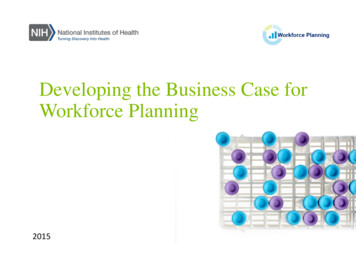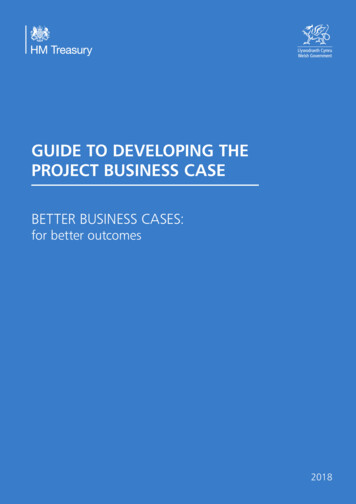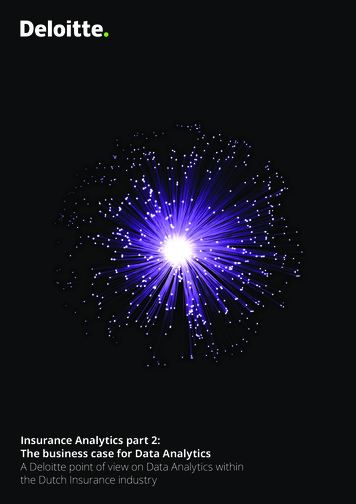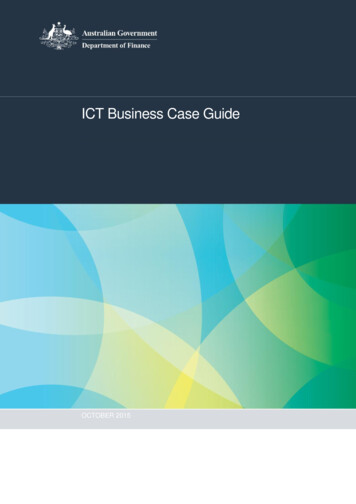
Transcription
Developing the Business Case forWorkforce Planning2015
Table of Contents3Introduction4The Value of Workforce Planning5How to Use This Tool6Tool Summary7Establish the Need8Outline Recommendations9Costs & Benefits10Assumptions & Risks11Implementation Options12Conclusion13Create Your Own
IntroductionWelcome to the NIHWorkforce Planning Toolkit.This toolkit was developed to help you jumpstart workforce planningactivities in your organization. It is a collection of tools, procedures,points-of-contacts, and case studies that will help you implementsuccessful workforce planning activities to achieve your desiredoutcomes.What is WorkforcePlanning?Workforce Planning is theprocess of analyzing, forecastingand planning workforce supplyand demand, assessing gaps, anddetermining targeted talentmanagement interventions toensure that an organization hasthe right people – with the rightskills in the right places at theright time – to fulfill its mandateand strategic objectives.How is Workforce Planning being conducted atNIH?NIH Leadership desired a systematic process for ensuring the agency’shuman capital strategy addresses organizational goals by aligning theworkforce to current and future requirements, determining wherethere is a misalignment, and developing strategies to address thosechallenges. The NIH Workforce Planning Working Group (WFP WG),with members from all across the Institutes and Centers (ICs), wasestablished in March 2013 to begin to address these challenges. Thistoolkit is one of the products of their work.Why do Workforce Planning at NIH?Workforce planning has a myriad of drivers both external and internal to NIH including: Chief Human Capital Officers (CHCO) Act of 2002 – requires NIH to “ assess workforce characteristics and futureneeds based on agency mission and strategic plan ”. 5 CFR, Part 250 (Personnel Management in Agencies), Subpart B (Strategic Human Capital Management), 203(Agency Responsibilities) – requires NIH to “ document the current state of the workforce, project humanresources needed to achieve program performance goals, identify shortfalls or gaps, and describe occupationsmost critical to agency performance ”. Workforce planning can help solve many common organizational challenges such as: Budget Cuts Skill Gaps Realignment Change in mandate3
The Value of Workforce PlanningCreation of new organizational unit or the merger of existing unitsRequests to justify personnel costs for budget/accounting purposesAbnormal levels of attrition or retirements (current or anticipated)How canworkforceplanning helpme?It is important to engage business leadersas you develop your business case forworkforce planning. The more tangibleand relevant the benefits are to yourspecific organization, the stronger yourbusiness case will be. If you are havingtrouble thinking of benefits specific toyour organization, think instead of whatmight happen if you do not take action.Gaps with employee levels, competencies, or skillsChanges to an existing organizational unit and/or processes within that unitRequests to assess organizational and/or employee performanceChanges in business model requiring new skill sets or revised staffing levelsWhen properly implemented, workforce planning can: Identify staffing levels and competencies required to support both short- and long-termstrategies and goals to minimize the chance of workforce misalignment Address gaps between the current and desired future workforce and defines these talentsurpluses and shortages Align the workforce with business plans to appropriately target and prioritize skillrequirements and transition strategies Support organizational change efforts and create a roadmap to achieve an ideal futureworkforce4
How to Use This ToolThe right toolfor the right job.The objective of this tool is to help you create your own workforceplanning business case. This guide will explain the different sections of aworkforce planning business case and the attached business casetemplate will help you organize your own. Once you have establishedthe need for workforce planning, you can refer to other tools in thetoolkit to implement your own workforce planning strategy.This tool is just one component of a largerworkforce planning toolkit with manytools, processes, and case studies to assistyou as you implement workforce planningin your organization. You might also wantto explore the following tools in thetoolkit: How-To Guide: Conducting aCustomer Needs Assessment Strategic Workforce Planning StatusAssessment Strategic Workforce Plan TemplateNIH Workforce Planning Toolkit5
Tool SummaryExecutive SummaryEstablish the NeedDeveloping thebusiness casefor workforceplanning.A business case is an argument, usually indocument form, developed to convinceorganizational decision makers to useresources to pursue a certain initiative.This tool lays out the key reasons whydecision makers should take a proposedapproach to solving workforce planningchallenges. This tool also provides a highlevel template to help you develop yourown business case for workforceplanning.Outline RecommendationsDiscuss the Costs & BenefitsDiscuss Assumptions & RisksOutline Implementation OptionsConclusion“Depending on your needs, a business casecan either be general and concise with highlevel, qualitative arguments or lengthy and indepth with large amounts of quantitative dataand models”.6
1Executive Summary Although the executive summary is at thebeginning of the business case, it should be writtenafter you’ve completed the other sections. Keep the summary short (1-2 pages) and highlightthe main points.
2Establish the NeedBudget CutsWhat canworkforceplanning helpresolve?The first step to building a case isidentifying an organizational challenge orissue that workforce planning can helpresolve. Workforce challenges often arisedue to a high level change in mission orshift in skills need.By strategically planning its workforce,an organization can ensure that it hasaccess to the skills needed to meetcurrent and future mission needs despitechanges to budget.RealignmentOften times an organization’s skillsneeds will shift over time. By usingworkforce planning, an organizationwill know where it has existing skillsetsand can internally streamline positiontransitions with relative ease.Skill GapsBy strategically planning its workforce,an organization will know where there isa skill need for its current and futurestate, allowing it to strategically plantalent distributions to meet missionneeds of today and tomorrow.Change in MandateA change in an agency’s mandate canmean a change in the scope or needsof its work. Having an active workforceplan will position an agency toproactively reshape its existing andfuture workforce skills profile to meetnew mission needs.8
3Outline RecommendationsHow canworkforceplanning helpresolve theissue identified?The next step is to clearly layout yourproposed workforce planning solution andclearly state how it will address the issueyou identified earlier. Remember,workforce planning does not need to besophisticated to add value to anorganization.Why am I proposing the implementation of WFP? Howwill it address the identified issue?Reflecting back on the organizational challenges you identified for this case, thinkabout how the proposal will specifically address the issue. Make it very obvious to thereader!What is the scope and vision of my proposal?Discuss how the proposal is feasible given any constraints that may be facing you or theorganization. Sometimes the best solutions are the simplest ones. Layout for the readerhow the proposal’s vision and scope is appropriate within the context of yourorganization.What is my ideal vision and outcome from the proposedimplementation?In order to persuade organizational decision makers to implement the proposal, it isimportant that the benefits of the proposal are clearly articulated. Additionally, it isimportant to thoroughly consider and define the goals of the proposal so that theimplementation process has clear direction. What are the ideal outcomes of yourapproach? Is there a clear direction? Does it add value to your organization?9
4Discuss the Costs & BenefitsWhat are thecosts andbenefits?Are there any potential costs toimplement the proposed solution? Whatare the manpower costs (how manypeople would it take) and operationalcosts (if we do this, what falls off theplate)? What are the benefits toimplementing the proposed solution (thebenefits should outweigh the costs)?Beyond the intended benefits andoutcomes think about any secondarybenefits or longer-term benefits thatmight arise.CostsExamples:Manpower How many people would it require toimplement? Are those people identifiable and available? If not, is there a cost to finding them?Operational How would workload need to shift if this wasimplemented? What would not get done? What might happen if the proposal isn’timplemented?Types of Costs What is the initial cost (current fiscal year)? Are there ongoing costs (maintenance)? What are the one time costs vs. recurring?BenefitsExamples:Quantitative: Headcount reduction: Salaries, benefits,bonuses Technology savings: Hardware, software,maintenance, upgrades, licenses, vendors General and Administrative savings: Utilities,insurance, rent, supplies, communications Other savings: Rent, furniture, legal andconsulting fees, printing, travelQualitative: Service quality, flexibility, scalability,compliance, customer-centric service delivery,and the ability to be more “strategic”10
5Discuss Assumptions & RisksWhat are theassumptionsand risks?What are the assumptions on which theproposal is dependent (i.e. what factorsare "assumed" to be true)? This could beanything from assumptions about staffthat will be available, budget that will beavailable, technology that will integrateproperly, etc. It is important tocommunicate these things to the readerto ensure they agree with thoseassumptions. Additionally, what risksshould the reader be aware of that mightimpact the success of the proposal? Howmight these risks be mitigated oreliminated?Assumptions Risks“Factors that are assumed to be true”“Things that might impact success”Examples:Examples:Available StaffSufficient BudgetAvailable workload capacityStaff with necessary skillsProvide a detailed listing of theassumptions you use in yourcost/benefit determination andyour overall proposal. Hostile business environmentStakeholder buy-inOrganizational cultureData unavailabilityAre the risks too significant tojustify implementing theproposal? How can the risks bemitigated or eliminated?11
6Outline Implementation OptionsApproachWhat are theimplementationoptions?Describe the different options forimplementing the proposal and discussthe pro's and con's of each option. Whatis the recommended option and why?Does the proposal need to beimplemented all at once to be effective?Can it be done in phases or in a piecemeal approach? Would that affect itsorganizational impact?Examples:“Big Bang” Implementation of proposal will be completedall at oncePhased Implementation of proposal will be completedover an estimated set of yearsAdditional ItemsExamples:TimelinesEstimate of ResourcesRequiredProject TollgatesPost-project evaluationplan12
7ConclusionState the benefits tothe stakeholderThe conclusion.The final step is to reiterate the benefitsof your proposal, qualitative andquantitative, and link them to the reader'sstrategy and core concerns. You shouldalso state the immediate next steps.Finally, remember to include theexecutive summary (easier to complete atthe end).What is being gained or prevented byimplementing this proposal?Convince them to careHow does it address the stakeholder’s coreconcerns and strategy?Immediate Next StepsWhat actions need to be taken to get started?13
Create Your Own Business CaseMy Business CaseNow it’s yourturn.Now that you understand the differentcomponents of a workforce planningbusiness case, it's time to create yourown! Refer to the correspondingtemplate in the toolkit to get started.You will find a basic structure for creatinga business case with appropriately labeledsections with guiding questions. You mayneed to rearrange or omit certain sectionsbased on your specific needs as theymight not all be relevant.Executive SummaryWorkforce IssueRecommendationCosts & BenefitsGood luck!14
A business case is an argument, usually in document form, developed to convince organizational decision makers to use resources to pursue a certain initiative. This tool lays out the key reasons why decision makers should take a proposed approach to solving work











